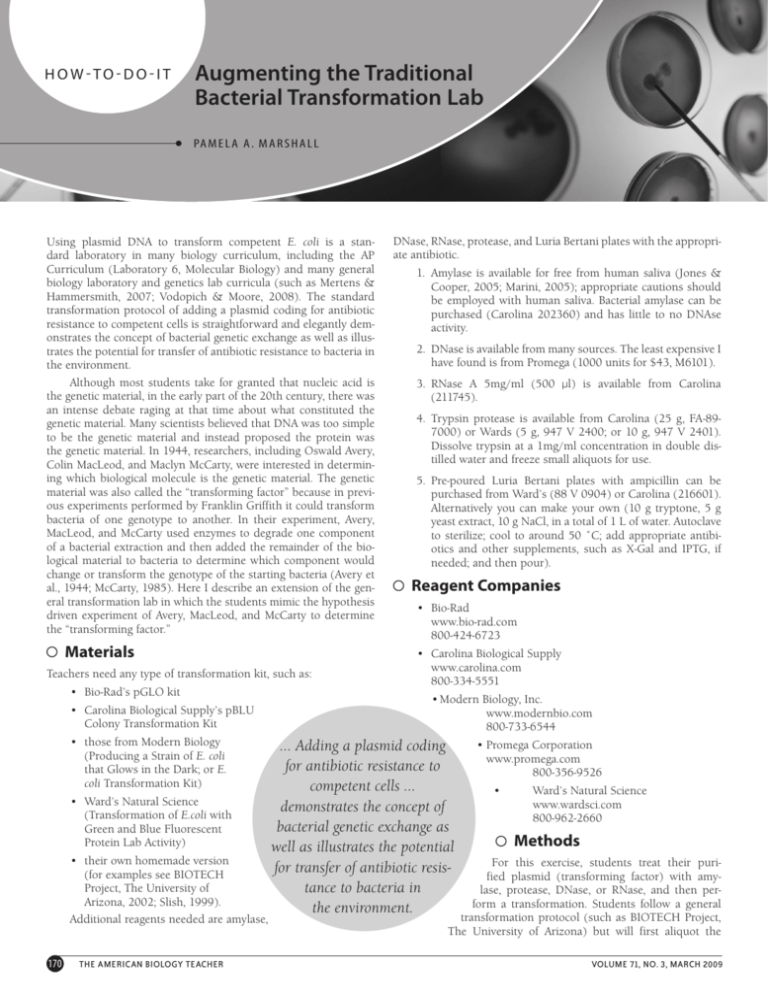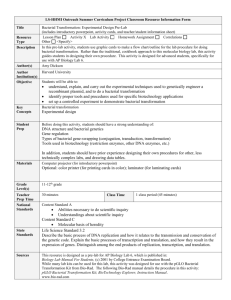
HOW-TO-DO-IT
Augmenting the Traditional
Bacterial Transformation Lab
PA M E L A A . M A R S H A L L
Using plasmid DNA to transform competent E. coli is a standard laboratory in many biology curriculum, including the AP
Curriculum (Laboratory 6, Molecular Biology) and many general
biology laboratory and genetics lab curricula (such as Mertens &
Hammersmith, 2007; Vodopich & Moore, 2008). The standard
transformation protocol of adding a plasmid coding for antibiotic
resistance to competent cells is straightforward and elegantly demonstrates the concept of bacterial genetic exchange as well as illustrates the potential for transfer of antibiotic resistance to bacteria in
the environment.
DNase, RNase, protease, and Luria Bertani plates with the appropriate antibiotic.
Although most students take for granted that nucleic acid is
the genetic material, in the early part of the 20th century, there was
an intense debate raging at that time about what constituted the
genetic material. Many scientists believed that DNA was too simple
to be the genetic material and instead proposed the protein was
the genetic material. In 1944, researchers, including Oswald Avery,
Colin MacLeod, and Maclyn McCarty, were interested in determining which biological molecule is the genetic material. The genetic
material was also called the “transforming factor” because in previous experiments performed by Franklin Griffith it could transform
bacteria of one genotype to another. In their experiment, Avery,
MacLeod, and McCarty used enzymes to degrade one component
of a bacterial extraction and then added the remainder of the biological material to bacteria to determine which component would
change or transform the genotype of the starting bacteria (Avery et
al., 1944; McCarty, 1985). Here I describe an extension of the general transformation lab in which the students mimic the hypothesis
driven experiment of Avery, MacLeod, and McCarty to determine
the “transforming factor.”
3. RNase A 5mg/ml (500 µl) is available from Carolina
(211745).
Materials
Teachers need any type of transformation kit, such as:
• Bio-Rad’s pGLO kit
• Carolina Biological Supply’s pBLU
Colony Transformation Kit
• those from Modern Biology
(Producing a Strain of E. coli
that Glows in the Dark; or E.
coli Transformation Kit)
• Ward’s Natural Science
(Transformation of E.coli with
Green and Blue Fluorescent
Protein Lab Activity)
• their own homemade version
(for examples see BIOTECH
Project, The University of
Arizona, 2002; Slish, 1999).
Additional reagents needed are amylase,
170
THE AMERICAN BIOLOGY TEACHER
1. Amylase is available for free from human saliva (Jones &
Cooper, 2005; Marini, 2005); appropriate cautions should
be employed with human saliva. Bacterial amylase can be
purchased (Carolina 202360) and has little to no DNAse
activity.
2. DNase is available from many sources. The least expensive I
have found is from Promega (1000 units for $43, M6101).
4. Trypsin protease is available from Carolina (25 g, FA-897000) or Wards (5 g, 947 V 2400; or 10 g, 947 V 2401).
Dissolve trypsin at a 1mg/ml concentration in double distilled water and freeze small aliquots for use.
5. Pre-poured Luria Bertani plates with ampicillin can be
purchased from Ward’s (88 V 0904) or Carolina (216601).
Alternatively you can make your own (10 g tryptone, 5 g
yeast extract, 10 g NaCl, in a total of 1 L of water. Autoclave
to sterilize; cool to around 50 ˚C; add appropriate antibiotics and other supplements, such as X-Gal and IPTG, if
needed; and then pour).
Reagent Companies
• Bio-Rad
www.bio-rad.com
800-424-6723
• Carolina Biological Supply
www.carolina.com
800-334-5551
• Modern Biology, Inc.
www.modernbio.com
800-733-6544
... Adding a plasmid coding
for antibiotic resistance to
competent cells ...
demonstrates the concept of
bacterial genetic exchange as
well as illustrates the potential
for transfer of antibiotic resistance to bacteria in
the environment.
• Promega Corporation
www.promega.com
800-356-9526
•
Ward’s Natural Science
www.wardsci.com
800-962-2660
Methods
For this exercise, students treat their purified plasmid (transforming factor) with amylase, protease, DNase, or RNase, and then perform a transformation. Students follow a general
transformation protocol (such as BIOTECH Project,
The University of Arizona) but will first aliquot the
VOLUME 71, NO. 3, MARCH 2009
“transforming factor” into five separate aliquots and treat each
one with 1 µl of the appropriate enzyme or control. This enzymatic treatment is incubated at 37 ˚C for 30 minutes and then
is used in a standard transformation lab protocol. DNAse is
robust enough that it works in this procedure, even without the
included buffer.
The following week students return to analyze their plates
to determine what molecule is the genetic material that will transform bacteria. This activity can be done with any transformation
lab exercise available and turns a simple transformation lab into
an inquiry-based activity (National Research Council, 2003). The
extension requires two additional steps to the traditional transformation protocol: to allow the students time to treat their DNA
sample and then to have more plates available for the students
to transform the appropriate number of aliquots of competent
cells (usually six: no DNA negative control, positive control of
plasma with no treatment, amylase, protease, DNase, and RNase
treatment). This extension of the traditional transformation lab
can demonstrate then to the students the results similar to what
Oswald Avery, Maclyn McCarty, and Colin MacLeod saw, that
DNA is in fact the transforming factor!
Acknowledgment
BIO
I gratefully acknowledge Dr. Charles E. Deutch for initial discussion and ideas that led to the development of this lab.
PAMELA A. MARSHALL is Assistant Professor, Division of Mathematical and
Natural Sciences, Arizona State University at the West Campus, Phoenix, AZ
85069-7100; e-mail: Pamela.Marshall@ASU.edu.
THE AMERICAN BIOLOGY TEACHER
References
Avery, O.T., MacLeod, C.M. & McCarty, M. (1944). Studies on the chemical nature
of the substance inducing transformation of pneumonococcal types:
induction of transformation by a desoxyribonucleic acid fraction isolated from pneumococcus type III. The Journal of Experimental Medicine
79(2), 137-158.
Biotech Project. The University of Arizona. (2002). Teacher Guide: Bacterial
Transformation with Mystery DNA. Retrieved February 11, 2008, from
The University of Arizona Biotech Project Web site at: http://biotech.
biology.arizona.edu/labs/transformation(TG).html.
Jones, M.A. & Cooper, C.L. (2005). Testing human saliva for enzyme activity: Use
of an in-class kinetic experiment for nonscience majors in a large classroom setting. The Chemical Educator, 10(1), 26-28.
Marini, I. (2005). Discovering an accessible enzyme: Salivary α-amylase.
Biochemistry and Molecular Biology Education, 33(2), 112-116.
McCarty, M. (1985). The Transforming Principle: Discovering that Genes are Made of
DNA. New York, NY: W.W. Norton & Company.
Mertens, T.R. & Hammersmith, R.L. (2007). Genetics Laboratory Investigations, 13th
Edition. Upper Saddle River, NJ: Pearson Prentice Hall.
National Research Council. (2003). Bio 2010: Transforming Undergraduate
Education for Future Research Biologists. Washington, DC: The National
Academies Press.
Slish, D.F. (1999). Bacterial transformation. Retrieved January 16, 2008 from The
University of Plattsburg Web site at: http://faculty.plattsburgh.edu/donald.slish/Transformation.html.
Vodopich, D.S. & Moore, R. (2008). Biology Laboratory Manual to accompany
Brooker Biology. New York, NY: McGraw Hill Higher Education.
BACTERIAL TRANSFORMATION LAB
171









